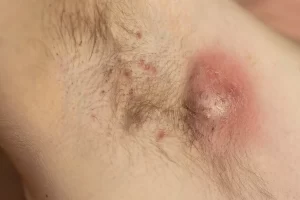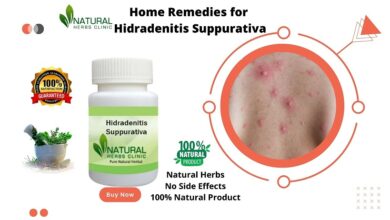Hidradenitis Suppurativa and Diabetes: How to Reduce Inflammation and Heal Faster

Hidradenitis Suppurativa (HS) is a painful, chronic skin condition that affects millions of people worldwide. For those living with diabetes, managing HS can be even more challenging. The combination of persistent inflammation, slow wound healing, and increased risk of infection creates a cycle that’s difficult to break. Hidradenitis Suppurativa and Diabetes in depth why these two conditions are linked, how they impact each other, and the most effective strategies to reduce inflammation and speed up healing.
Related Article: How to Cure Hidradenitis Suppurativa Naturally: Proven Methods for Clear Skin
What is Hidradenitis Suppurativa (HS)?
Hidradenitis Suppurativa (HS) is a chronic, inflammatory skin disease that affects the hair follicles and sweat glands, leading to painful lumps, abscesses, and tunnels (sinus tracts) under the skin. It’s sometimes called acne inversa, but it’s very different from common acne.

Here’s a detailed breakdown:
1. What’s happening in the body
HS begins when hair follicles become blocked not from poor hygiene, but due to a combination of immune system overreaction and abnormal follicular function.
- The blockage traps sweat, oil, and skin cells.
- This can cause swelling, rupture, and leakage of inflammatory material into surrounding tissue.
- The body responds with chronic inflammation, leading to abscesses, sinus tracts, and scarring.
2. Common locations
HS usually appears in areas where skin rubs together and where there are many sweat glands (apocrine glands), such as:
- Armpits
- Groin
- Inner thighs
- Buttocks
- Under the breasts
These areas are warm and moist, which can worsen the blockage and inflammation.
3. Symptoms
The condition tends to develop gradually and worsen over time without treatment. Key features include:
- Painful, deep lumps (nodules) under the skin
- Recurring abscesses that may burst and drain foul-smelling pus
- Sinus tracts (tunnel-like channels under the skin connecting lumps)
- Scarring and thickened skin over time
- Flares that come and go, sometimes triggered by friction, heat, stress, or hormones
4. Causes and risk factors
HS is not contagious and is not caused by poor hygiene. Its exact cause isn’t fully understood, but it’s believed to involve:
- Immune dysregulation (body’s immune system attacking hair follicles)
- Genetics – about 30–40% of people with HS have a family history
- Hormonal influences – often starts after puberty, may flare around menstruation
- Lifestyle factors that can worsen it:
- Smoking (strongly linked)
- Obesity (due to increased skin friction and inflammation)
5. Staging (Hurley classification)
Doctors classify HS into 3 stages:
- Stage I: Single or multiple isolated abscesses, no scarring or sinus tracts.
- Stage II: Recurrent abscesses with sinus tract formation and scarring, but in widely separated areas.
- Stage III: Diffuse or interconnected tracts and abscesses across an entire area.
What is Diabetes?
Diabetes (more correctly called Diabetes Mellitus) is a chronic medical condition that affects how your body turns food into energy, specifically how it handles blood sugar (glucose).

1. What happens in a healthy body
When you eat food especially carbohydrates your body breaks it down into glucose, which enters your bloodstream.
Your pancreas then produces a hormone called insulin. Insulin acts like a “key” that allows glucose to enter your cells, where it’s used for energy.
2. What happens in diabetes
In diabetes, this system doesn’t work properly. This can happen in two main ways:
- Your body doesn’t make enough insulin (or none at all).
- Your body can’t use insulin effectively (this is called insulin resistance).
As a result, glucose stays in your blood instead of going into your cells. Over time, high blood sugar can damage blood vessels, nerves, and organs.
3. Main types of diabetes
- Type 1 diabetes – The immune system attacks the insulin-producing cells in the pancreas. People with Type 1 need insulin injections for life.
- Type 2 diabetes – The body becomes resistant to insulin or doesn’t make enough. Often linked to lifestyle factors but also genetics.
- Gestational diabetes – Develops during pregnancy and usually disappears afterward, but it can increase the risk of Type 2 later.
4. Common symptoms
- Frequent urination
- Excessive thirst
- Unexplained weight loss
- Fatigue
- Blurred vision
- Slow healing of wounds
5. Why it’s important to control diabetes
Uncontrolled diabetes can lead to serious complications, such as:
- Heart disease
- Kidney failure
- Vision loss
- Nerve damage (neuropathy)
- Poor circulation, sometimes leading to amputations
Diabetes is not about eating “too much sugar” directly it’s about your body’s inability to regulate blood sugar due to problems with insulin production or function. It’s a long-term condition, but with proper treatment, diet, exercise, and monitoring, many people live healthy lives with it.
Related Article: 3 Effective Hidradenitis Suppurativa Treatment Home Remedies
The Link Between Hidradenitis Suppurativa and Diabetes
The connection between Hidradenitis Suppurativa and Diabetes is well-documented in medical research. Here’s why these two conditions often coexist:
1. Shared Inflammatory Pathways
Both Hidradenitis Suppurativa and Diabetes particularly Type 2 diabetes are linked to chronic low-grade systemic inflammation. Elevated levels of inflammatory cytokines (such as TNF-alpha and interleukin-1) can worsen both insulin resistance and HS flare-ups.
2. Obesity and Metabolic Syndrome
Many individuals with HS also have obesity, which is a major risk factor for Type 2 diabetes. Excess weight increases friction in skin folds, encourages bacterial growth, and worsens HS symptoms.
3. Impaired Immune Response
Diabetes impairs immune cell function, making it harder for the body to fight infections in HS lesions.
4. Slower Wound Healing
High blood sugar damages small blood vessels, reducing oxygen and nutrient delivery to damaged skin. This slows healing and increases the risk of chronic HS wounds.
5. Increased Risk of Infections
People with diabetes have a higher likelihood of skin infections, and in HS, this can mean more abscesses and delayed recovery.
Reducing Inflammation: A Key Goal for HS and Diabetes Management
Both Hidradenitis Suppurativa and Diabetes share a common culprit: chronic inflammation.
When the body’s immune system stays in “overdrive” for too long, it damages healthy tissues, worsens symptoms, and slows healing.
By actively reducing inflammation, you can improve skin health, stabilize blood sugar, and lower the risk of long-term complications.
Here’s how to target inflammation step by step:
1. Optimize Blood Sugar Control
High blood sugar acts like fuel for inflammation. The more often your glucose levels spike above the normal range, the more stress your immune system experiences.
Why it matters:
- Consistently high blood sugar increases inflammatory chemicals in the body.
- It also slows wound healing and makes skin infections more likely.
How to keep blood sugar in check:
- Monitor regularly – know your numbers and track trends.
- Adjust treatment – work with your doctor to fine-tune medications or insulin.
- Limit refined carbs & added sugars – swap soda, candy, and pastries for healthier alternatives.
- Eat balanced meals – include lean protein (chicken, fish, tofu), healthy fats (olive oil, avocado), and fiber (vegetables, legumes, whole grains) to prevent spikes.
2. Follow an Anti-Inflammatory Diet
Food can either fan the flames of inflammation or help put them out.
For both Hidradenitis Suppurativa and Diabetes, eating anti-inflammatory foods supports immune balance, skin repair, and blood sugar stability.
What to eat more of:
- Omega-3 rich foods – salmon, mackerel, flaxseeds, chia seeds, walnuts (reduce inflammation at a cellular level).
- Antioxidant-rich vegetables – spinach, kale, broccoli, bell peppers (protect cells from oxidative stress).
- Low-glycemic fruits – berries, cherries, apples (provide vitamins without sharp blood sugar spikes).
- Fermented foods – yogurt, kefir, sauerkraut (support gut bacteria, which influence inflammation).
What to limit or avoid:
- Sugary snacks and drinks (cause spikes in glucose and inflammation).
- Processed meats (linked to increased HS flare frequency).
- Dairy (may trigger HS in some individuals observe your body’s reaction).
- High-glycemic carbs like white bread, pasta, and pastries (raise blood sugar quickly).
3. Maintain a Healthy Weight
Carrying extra weight increases skin friction in HS-prone areas and worsens insulin resistance in diabetes.
Benefits of modest weight loss (5–10% of body weight):
- Fewer HS lesions and reduced flare-ups.
- Better insulin sensitivity, meaning your body uses sugar more effectively.
- Lower levels of inflammatory markers in the blood.
Tip: Focus on gradual, sustainable changes fast, extreme diets can backfire and cause nutrient deficiencies.
4. Quit Smoking
Smoking is one of the strongest lifestyle factors linked to HS severity.
It also harms blood vessels, making it harder for the skin to heal, and worsens insulin resistance.
Benefits of quitting:
- Reduces systemic inflammation.
- Improves skin oxygenation and wound healing.
- Lowers the risk of heart disease, which is already higher in people with diabetes.
5. Manage Stress Effectively
Stress isn’t just a mental burden it’s a physical trigger for both Hidradenitis Suppurativa and Diabetes.
When stress is constant, cortisol (the stress hormone) stays high, which can:
- Raise blood sugar levels.
- Trigger HS flares.
- Disrupt sleep and healing.
Proven stress-relief techniques:
- Deep breathing – slows the heart rate and calms the nervous system.
- Gentle yoga or stretching – reduces muscle tension and promotes circulation.
- Mindfulness meditation – trains the brain to focus on the present instead of future worries.
- Spending time outdoors – natural light and fresh air can boost mood and lower stress hormones.
Healing HS Lesions Faster in Diabetes
For people with hidradenitis suppurativa and diabetes, managing both conditions is important for faster healing. While reducing inflammation helps prevent new HS lesions from forming, proper wound care is key to speeding up recovery of existing ones.
1. Keep Blood Sugar in a Healthy Range
When blood sugar levels are too high, the body’s ability to repair skin slows down. This happens because high glucose levels:
- Reduce collagen production, which is needed for building new skin tissue.
- Weaken the immune system, making it harder to fight infection.
Keeping blood sugar in target range helps wounds close faster and lowers the risk of complications.
2. Gentle Cleansing
Clean HS lesions once daily using a mild, fragrance-free cleanser. Avoid products with alcohol, strong fragrances, or harsh chemicals, as they can irritate the skin.
- Do not scrub the area roughly, as this can cause more skin trauma and slow healing.
- Gently pat the area dry with a soft towel instead of rubbing.
3. Use Antimicrobial Solutions
A diluted antiseptic wash, such as chlorhexidine, can help kill harmful bacteria on the skin.
- This reduces the bacterial load and lowers the chance of infection.
- Use only as directed by your healthcare provider, since overuse may irritate the skin.
4. Moist Wound Healing
Wounds heal faster in a slightly moist environment.
- Dressings such as hydrocolloids or foam dressings keep the wound moist, which:
- Promotes faster tissue repair
- Reduces pain and itching
- Protects against dirt and bacteria
- Change dressings as recommended by your healthcare provider to avoid trapping excess fluid.
5. Avoid Skin Trauma
Friction and pressure can worsen HS lesions.
- Wear loose-fitting, breathable cotton clothing to reduce rubbing.
- Avoid tight seams or synthetic fabrics that trap sweat and heat.
- Try to limit activities that cause repeated friction in affected areas.
6. Topical and Oral Medications
Your doctor may recommend one or more of the following treatments:
- Topical clindamycin for mild HS to reduce bacteria and inflammation.
- Oral antibiotics for infected lesions.
- Biologic therapies like adalimumab for severe or recurring HS.
- Zinc supplements to support healing and help control inflammation.
7. Treat Secondary Infections Promptly
If a lesion becomes:
- Red
- Hot to the touch
- Swollen
- Producing foul-smelling drainage
…these may be signs of infection. Seek medical care immediately to prevent the infection from spreading.
Related Article: Natural Remedies for Hidradenitis Suppurativa Reduce Growth of More Lumps
Natural Treatments That Benefit Both HS and Diabetes
Here’s a clear, evidence-based guide on Natural Treatments of Hidradenitis Suppurativa that can benefit both Hidradenitis Suppurativa and Diabetes. Since both conditions involve inflammation, insulin resistance, and metabolic health, there’s significant overlap in what can help.
1. Anti-Inflammatory Diet
- Why it helps both: Chronic inflammation worsens HS flare-ups and insulin resistance in diabetes.
- What to focus on:
- High-fiber vegetables: Broccoli, spinach, kale, zucchini, Brussels sprouts
- Low-glycemic fruits: Berries, cherries, apples, pears
- Healthy fats: Extra virgin olive oil, avocado, nuts, seeds
- Lean protein: Fish (especially salmon, sardines), skinless poultry, plant-based proteins
- Spices: Turmeric + black pepper, ginger, cinnamon (helps regulate blood sugar)
2. Weight Management
- Why it helps both: Even modest weight loss (5–10%) can improve insulin sensitivity and reduce HS flare frequency.
- Approach:
- Calorie-conscious eating without crash dieting
- Walking or gentle resistance training
- Avoiding prolonged sitting
3. Blood Sugar Stabilization
- Why it helps both: Blood sugar spikes promote inflammation, worsening HS lesions.
- Strategies:
- Eat balanced meals with protein + healthy fat + fiber
- Avoid refined carbs and sugary drinks
- Space meals to avoid constant snacking
4. Vitamin D Optimization
- Why it helps both: Low vitamin D is linked to higher inflammation, worse HS severity, and poor insulin control.
- How to improve:
- Safe sun exposure (10–20 min a few times per week)
- Vitamin D3 supplementation (get levels tested before starting)
5. Zinc and Omega-3 Fatty Acids
- Why they help both:
- Zinc supports wound healing and immune balance.
- Omega-3s (from fatty fish, flaxseed, chia) reduce inflammation and improve insulin function.
6. Gut Health Support
- Why it helps both: Poor gut microbiome balance increases systemic inflammation.
- Ways to support:
- Probiotic-rich foods (unsweetened yogurt, kefir, sauerkraut, kimchi)
- Prebiotic fibers (garlic, onions, asparagus)
7. Stress Reduction
- Why it helps both: Stress hormones spike blood sugar and worsen inflammatory skin conditions.
- Options:
- Mindfulness meditation or breathing exercises
- Yoga or gentle stretching
- Nature walks
8. Avoiding HS and Diabetes Triggers
- For both conditions, consider limiting:
- Dairy (linked to HS flares in some people)
- High-glycemic foods (white bread, sweets)
- Highly processed meats and fried foods
Related Article: Make Use of Given 10 Natural Remedies for Hidradenitis Suppurativa
Lifestyle Habits That Support Healing
For Hidradenitis Suppurativa and Diabetes, consistent lifestyle adjustments can lead to significant improvement.
1. Regular Exercise
Low-impact activities like swimming, cycling, or walking:
- Improve blood circulation
- Reduce insulin resistance
- Boost mood
Avoid exercises that cause excessive sweating or friction in affected areas.
2. Adequate Sleep
Poor sleep increases inflammation and impairs wound healing. Aim for 7–9 hours per night.
3. Hydration
Proper hydration supports skin elasticity and helps the body flush out toxins.
4. Clothing Choices
Opt for:
- Moisture-wicking fabrics
- Seamless underwear
- Sports bras with minimal seams to reduce irritation
Long-Term Prevention Strategies
1. Keep a Flare Diary
Track foods, activities, stress levels, and blood sugar readings to identify patterns that trigger HS flares.
2. Regular Medical Checkups
- Monitor HbA1c levels for long-term blood sugar control.
- Schedule dermatology visits for HS management.
3. Vaccinations
Stay up to date on vaccines to reduce infection risk, as both HS lesions and diabetes make infections more dangerous.
4. Early Intervention
Treat new HS bumps promptly to prevent them from becoming larger, more painful abscesses.
Conclusion
The relationship between Hidradenitis Suppurativa and Diabetes is complex but manageable. By targeting inflammation, optimizing blood sugar control, and practicing meticulous wound care, individuals can reduce flare-ups, heal faster, and improve quality of life.
The key is early intervention and consistent management both for HS and diabetes. A combination of dietary changes, medical treatments, and lifestyle adjustments can make a significant difference in reducing pain, preventing complications, and regaining confidence.
Related Article: Get Hidradenitis Suppurativa Home Remedies to Relieve the Symptoms
Related Article: The Science Behind Essential Oils for Hidradenitis Suppurativa Relief




